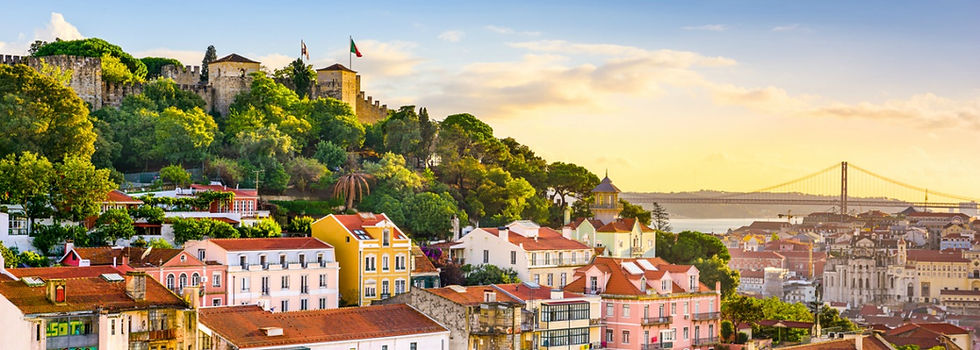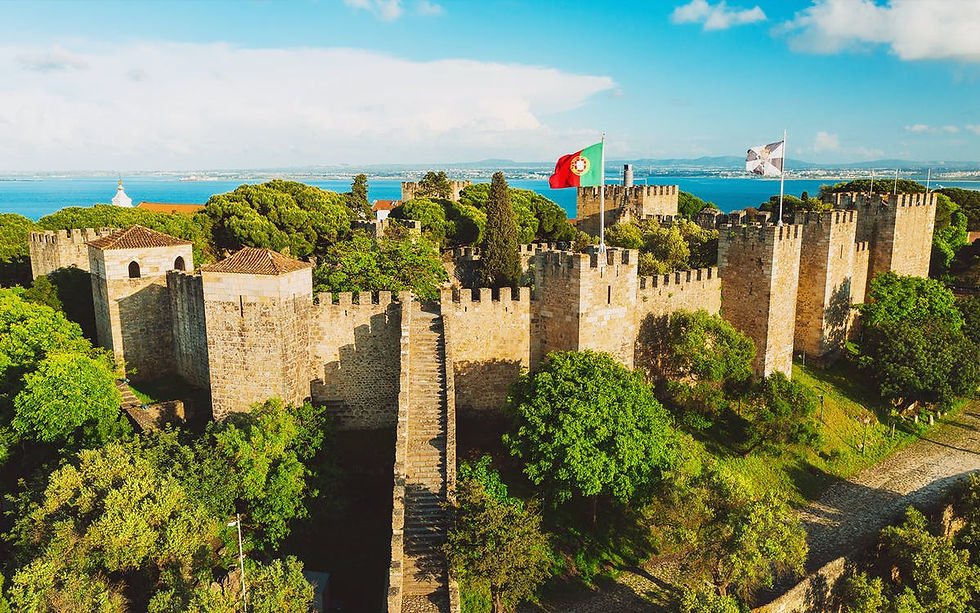
If you're planning a visit to Lisbon, Portugal’s sun-soaked capital, you're in for a treat. Known for its rich history, vibrant neighbourhoods, and jaw-dropping coastal views, Lisbon is a city that never fails to captivate its visitors. Whether you’re touching down at Lisbon Airport for the first time or you’re a seasoned traveller returning to this iconic city, there's always something new to discover in this bustling metropolis.
After reading my comprehensive guide to navigating Lisbon Airport, you're probably feeling confident about getting from the airport to the city centre. Now, it’s time to dive deeper into what makes Lisbon one of Europe’s most exciting destinations and explore the sights, flavours, and hidden gems that should top your itinerary.
Arriving in Lisbon: A Smooth Transition from Airport to City Center
Let’s quickly recap: once you’ve landed at Humberto Delgado Airport (Lisbon’s main international hub), you’ll want to choose the best route to whisk you into the city's heart. Whether you’re hopping on the Aerobus, riding the metro, or opting for a taxi, getting from the airport to Baixa or Chiado—Lisbon's downtown areas—is a breeze. Be sure to download the Viva Viagem card for public transport, as it's an affordable and easy way to travel around the city.
But what awaits you once you’ve arrived? Lisbon's charms unfold as soon as you start exploring, and your first steps into the city should lead you straight to one of its most significant landmarks: Lisbon Cathedral.
Lisbon Cathedral: From Islamic Mosque to Christian Cathedral
No visit to Lisbon is complete without a trip to the iconic Lisbon Cathedral (Sé de Lisboa), one of the city’s most important historical landmarks. Steeped in history and symbolizing a turning point in Lisbon’s past, the cathedral is more than just a stunning piece of architecture—it’s a testament to the city’s resilience and its transformative journey through centuries of conflict and triumph.
Originally built in the 12th century, Lisbon Cathedral stands on the site of what was once a grand Islamic mosque, reflecting the Moorish influence that dominated the Iberian Peninsula. After the Reconquista, when King Afonso I recaptured Lisbon from the Moors, the mosque was torn down, and the cathedral was constructed as a bold symbol of Christianity’s return to power. It remains one of the most visited sites in Lisbon to this day.

What to Explore Inside Lisbon Cathedral:
The Romanesque Facade: As you approach the cathedral, you'll be struck by its fortress-like exterior. The Romanesque design reflects its history as both a religious building and a protective stronghold during times of conflict.
Gothic Cloister: Inside the cathedral, don’t miss the stunning Gothic cloister, where medieval architecture merges with Roman and Moorish ruins. This peaceful courtyard, dotted with archaeological relics, is a true gem.
The Treasury: For those who love a bit of treasure hunting, head to the cathedral’s upper levels to explore the treasury, which holds a collection of religious artefacts, including relics of Saint Vincent, Lisbon’s patron saint.
Lisbon Cathedral isn’t just a place of worship; it’s a journey through the city’s turbulent past. A visit here is a perfect way to immerse yourself in Lisbon’s rich heritage and architectural splendour.
Exploring Alfama: Lisbon’s Oldest Neighborhood
Once you’ve visited Lisbon Cathedral, step outside and you’ll find yourself at the gateway to the city’s oldest neighbourhood, Alfama. This charming district, with its narrow, winding streets and centuries-old buildings, offers a real taste of traditional Lisbon. It’s a place where time seems to have stood still, and as you wander through, you’ll feel like you’ve stepped into a different world. Here’s what you shouldn’t miss:
Alfama’s Streets: Wander through Alfama’s maze of cobblestone streets, where every corner reveals a new surprise—whether it’s a hidden square, a quaint café, or a glimpse of daily life as locals chat from their windows. The neighbourhood’s layout is famously irregular, a legacy of its Moorish past, designed to create shade and protection from the heat. Unlike other parts of Lisbon, Alfama survived the devastating 1755 earthquake, so its medieval charm remains intact. As you explore, don’t miss Largo do Chafariz de Dentro, one of Alfama’s most picturesque squares, or the Miradouro de Santa Luzia, a scenic lookout point with stunning views over the red rooftops of Alfama and the Tagus River.
São Jorge Castle: Dominating the skyline above Alfama is the majestic São Jorge Castle. For panoramic views of Lisbon, make your way up the hill to this impressive fortress, which dates back to the Moorish period. The castle was once a royal palace and a stronghold during times of conflict, offering sweeping views over the city and the river. As you walk through the castle’s ancient walls and towers, take a moment to imagine the history that unfolded here—battles fought, sieges endured, and kings who ruled from its heights. The camera obscura inside the castle provides a fascinating 360-degree real-time view of the city, and the castle gardens, filled with peacocks, offer a peaceful retreat after your climb.

Fado Music: No trip to Alfama is complete without experiencing Fado, Portugal’s hauntingly beautiful traditional music. Alfama is the birthplace of fado, and its narrow streets have echoed with these soulful melodies for centuries. Fado is more than just music—it’s an expression of saudade, a deep sense of longing and melancholy that is deeply rooted in Portuguese culture. In Alfama, you’ll find some of the most authentic fado houses in the city. Places like Clube de Fado and Parreirinha de Alfama offer intimate performances where singers, accompanied by the classic Portuguese guitar, pour their hearts out through songs of love, loss, and nostalgia. Enjoy an evening performance while savouring traditional Portuguese dishes, and let the music transport you to another time. For a deeper understanding of this art form, visit the Museu do Fado, located at the edge of Alfama, where you can learn about Fado’s history and its significance in Portuguese culture.
Discovering Lisbon’s Craft Beer Scene

While Lisbon is famous for its wine, especially port and green wine (vinho verde), the city has also become a haven for craft beer enthusiasts. Over the last decade, Lisbon’s craft beer scene has exploded, with local brewers crafting bold and innovative beers that are gaining attention both locally and internationally.
If you’re a fan of craft beer, here are a few spots you should check out:
Duque Brewpub: Tucked away in Bairro Alto, this cosy brewpub offers an impressive selection of Portuguese craft beers on tap. Their rotating list often features both well-known local brewers and experimental newcomers.
Cervejaria Trindade: While this is Lisbon’s oldest brewery, it now offers a modern craft beer selection alongside its traditional brews. The setting in an old monastery adds to its unique charm.
Dois Corvos Brewery: Located in the Marvila district, Dois Corvos is one of Lisbon’s most prominent craft breweries. Known for its wide range of experimental and classic beer styles, from IPAs to stouts, Dois Corvos is a must-visit for any craft beer lover. Stop by their taproom to enjoy fresh beer straight from the source, often paired with street food from rotating vendors.
For the adventurous beer lover, Lisbon’s craft beer scene is a must-try. Pairing an afternoon of exploring the city with a cold, locally brewed beer is one of the many ways to experience Lisbon's evolving culture.
Tasting Lisbon’s Street Food Scene

While Lisbon’s dining scene is full of incredible restaurants, you don’t need to sit down for a meal to taste the best of the city’s flavours. Lisbon’s street food scene offers a delicious way to explore the local culture on the go. From traditional Portuguese snacks to international fusion, there’s something for everyone as you stroll through Lisbon’s bustling streets.
Here are a few must-try street food options:
Pastéis de Nata: These iconic custard tarts are a must-try. You’ll find them all over the city, with the best ones coming hot and fresh from local bakeries. Crispy on the outside and creamy on the inside, they are the perfect sweet treat for any time of day.
Bifana: This traditional Portuguese pork sandwich is simple yet bursting with flavour. Seasoned pork is served in a crispy roll and topped with mustard or spicy sauce for an extra kick. It’s the ideal snack while you’re on the go, and you’ll find it sold at many street stalls across the city.
Sardinhas Assadas: If you’re visiting during the summer, you can’t miss grilled sardines, a Lisbon staple often found at street fairs and festivals. Perfectly charred over an open flame, these sardines are typically served with a slice of bread and a drizzle of olive oil—simple yet bursting with flavour.

And while Lisbon's street food offers quick and tasty bites, there’s one sit-down spot you simply can’t miss—Bonjardim, known locally as the "Rei dos Frangos" (King of Chickens). This unassuming restaurant in the heart of the city has been serving some of the best roast chicken for decades, and it's a favourite with locals and visitors alike.
Bonjardim’s Legendary Chicken: Juicy, perfectly seasoned, and grilled to crispy perfection, the frango assado (grilled chicken) at Bonjardim is a must-try. Served with a side of fries, salad, and the restaurant’s signature piri-piri sauce, it’s a simple yet unforgettable meal. The chicken’s smoky flavour, combined with the tangy heat of the piri-piri, will leave you craving more. Whether you're sitting outside on their terrace or enjoying a cosy seat inside, this is the perfect spot to indulge after a day of exploring the city.
Exploring Lisbon’s street food scene is the perfect way to immerse yourself in the city’s flavours while soaking up the vibrant atmosphere. And whether you’re grabbing a bifana from a street vendor or sitting down to savour Bonjardim’s legendary chicken, you’ll be tasting the true essence of Lisbon.
Creative Lisbon: Exploring LX Factory
This former industrial complex turned creative hub is one of the city’s most exciting places to explore. Nestled beneath the 25 de Abril Bridge, LX Factory is a vibrant mix of art, culture, dining, and shopping.
In my video on LX Factory, I take you inside this unique space, where old factory buildings have been transformed into galleries, studios, cafés, and shops. If you’re into street art, this place is a must-see, with murals and installations covering nearly every wall.
Here’s what to check out while at LX Factory:
Ler Devagar: One of the most famous and photogenic bookstores in the world, this is a paradise for book lovers. With towering bookshelves and a suspended bicycle sculpture, it’s both a place to explore and an Instagram hotspot.
Art and Culture: From pop-up exhibitions to local artisan shops, LX Factory is a haven for creativity. You’ll find everything from handmade jewellery to contemporary art installations.
Food and Drink: Whether you’re looking for a craft beer, artisanal coffee, or a full meal, LX Factory has something for every taste. It’s a great spot to relax and recharge after a day of sightseeing.
LX Factory captures the energy of Lisbon’s modern, creative spirit while maintaining its industrial roots, making it a perfect stop for any visitor seeking a different side of the city.
Practical Tips for Visiting Lisbon
Before you set off on your Lisbon adventure, here are a few tips to ensure a smooth trip:
Language: Portuguese is the official language, but many locals in the tourist areas speak English.
Currency: The currency is the Euro (€), and you’ll find ATMs and currency exchanges throughout the city.
Best Time to Visit: Spring and autumn are ideal for visiting Lisbon, as the weather is pleasant and the city isn’t as crowded as during the summer months.
Tipping: Tipping in restaurants is common but not obligatory. Leaving a small amount (around 5-10%) is appreciated.
Final Thoughts on Visiting Lisbon
Lisbon is a city that never stops revealing its charms. From the historic grandeur of Lisbon Cathedral to the vibrant streets of Alfama, the modern creativity of LX Factory, and the evolving craft beer scene, every corner of this city tells a story. Whether you’re here for a weekend getaway or an extended stay, Lisbon’s blend of culture, history, and modern energy will leave you enchanted.
I hope this article was helpful to you and helps add to your future journey positively. Your support through sharing helps me continue creating content just like this! If you found this information valuable, please consider joining my mailing list (below) following me on Instagram or subscribing to my YouTube Channel. You can also support me by becoming a member on YouTube or SubscribeStar, or even just by buying me a coffee on Ko-Fi. I'm not sponsored by anyone, my content is independently provided because I believe it will be beneficial to readers like you.
Happy travels, The Wondering Englishman







































































































Comments